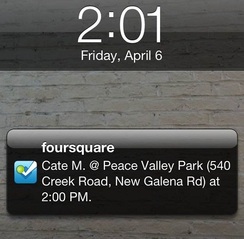5 Ways to Market Your Brand With Location-Based Networks
Between the rise in location-based social networks, like Foursquare, and the mobile market’s meteoric growth, a new marketing avenue has opened up. Location-based marketing is a nascent frontier, and marketers are clamoring to take advantage of it.
Already, about 30% of smartphone owners access social networks via their mobile browser, and that figure will continue to grow, according to an infographic by Microsoft Tag. So, if your marketing plans include location-based networks, below are five ways to get started.
1. Push Notification Integration
Click here To Read The Article
Already, about 30% of smartphone owners access social networks via their mobile browser, and that figure will continue to grow, according to an infographic by Microsoft Tag. So, if your marketing plans include location-based networks, below are five ways to get started.
1. Push Notification Integration
Click here To Read The Article
One of the big reasons people don’t use location-based apps like Foursquare or SCVNGR is simply because they forget. Integrating push notifications into a location-based app is a great and simple fix.
Marketers often use these notifications to highlight activity, specials, announcements, and to further promote the app as well as the business. Allowing users to alter these notifications is an important way to give your audience some power. That ensures your messaging makes it to their phone without being a burden.
2. Loyalty Programs
Giving rewards to loyal customers for continuing to check in via a location-based networks is a great option. Arby’s marketing team did this on Foursquare by offering special reserved seating to their Foursquare mayors at 30 restaurants and 50% off on purchases. Ideas like these drive competition and increase use, which leads to greater exposure for the business being marketed on these networks.
3. Geo fencing
Geofencing has been around for some time, but it’s increasingly becoming incorporated in more location-based networks. For those who aren’t familiar, geofencing is a virtual boundary set around a location, like a store. One way marketers are using geofencing on location-based networks is by sending messages to users who’ve opted in to a particular service.
Lets use Starbucks as an example. If a person crosses a Starbucks geofence, they will receive a message from their location-based app highlighting an offer, coupon, or just a reminder to stop by. This is similar to the idea of a push notification, except it’s only triggered by a person who comes into a geofence around a specific location. This messaging is more relevant to a user and more effective for a company.
4. Mixed Media
Marketers often use these notifications to highlight activity, specials, announcements, and to further promote the app as well as the business. Allowing users to alter these notifications is an important way to give your audience some power. That ensures your messaging makes it to their phone without being a burden.
2. Loyalty Programs
Giving rewards to loyal customers for continuing to check in via a location-based networks is a great option. Arby’s marketing team did this on Foursquare by offering special reserved seating to their Foursquare mayors at 30 restaurants and 50% off on purchases. Ideas like these drive competition and increase use, which leads to greater exposure for the business being marketed on these networks.
3. Geo fencing
Geofencing has been around for some time, but it’s increasingly becoming incorporated in more location-based networks. For those who aren’t familiar, geofencing is a virtual boundary set around a location, like a store. One way marketers are using geofencing on location-based networks is by sending messages to users who’ve opted in to a particular service.
Lets use Starbucks as an example. If a person crosses a Starbucks geofence, they will receive a message from their location-based app highlighting an offer, coupon, or just a reminder to stop by. This is similar to the idea of a push notification, except it’s only triggered by a person who comes into a geofence around a specific location. This messaging is more relevant to a user and more effective for a company.
4. Mixed Media
Apps like GetGlue and Foursquare both give you the ability to check in and incorporate other media. For instance, GetGlue allows a user to check in and share a favorite book, song or TV show. Optimize your content and forge partnerships with companies like GetGlue as a way to extend your reach among users that are more likely to view your content if recommended by their friends.
5. Better Content
5. Better Content
As the king of the location-based space, Foursquare helps set the tone for innovation in this industry. Recently at South by Southwest, Foursquare CEO Dennis Crowley spoke about the future of location-based apps and how the company’s focus is shifting from checking in to other features that their audience uses more and that will help the company become more mainstream.
For instance, Foursquare’s “explore” feature is fairly new and allows a user to discover food, nightlife, shops, and more based on broad categories. It aggregates suggestions based on your checkin history as well as information available on the network about a location. This is why any content you add to Foursquare and similar sites should be optimized.
For instance, Foursquare’s “explore” feature is fairly new and allows a user to discover food, nightlife, shops, and more based on broad categories. It aggregates suggestions based on your checkin history as well as information available on the network about a location. This is why any content you add to Foursquare and similar sites should be optimized.








